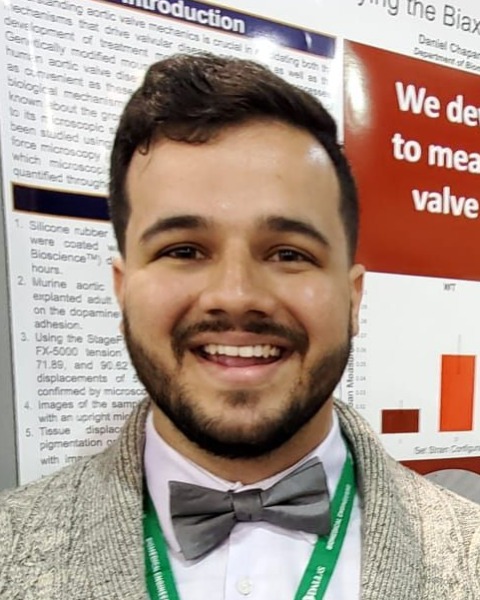Cardiovascular Engineering
(D-154) Asymmetric, leaflet specific, transcriptomic profiles in mouse aortic valve leaflets
Thursday, October 12, 2023
2:00 PM - 3:00 PM PDT
Location: Exhibit Hall - Row D - Poster # 154

Daniel Chaparro
PhD Student
Florida International University
Miami, Florida, United States- JH
Joshua D. Hutcheson
Associate Professor
Florida International University
Miami, Florida, United States
Presenting Author(s)
Last Author(s)
Introduction:: The aortic valve (AoV) is composed of distinct cellular phenotypes within striated extracellular matrix layers that together are responsible for normal valve function. Historically, the resident cells have been lumped into 2 major categories: valve interstitial (VICs) or valve endothelial cells (VECs). However, several groups have reported contributions of other cellular phenotypes within the tissue that may be involved in development, remodeling, and disease progression. Using single cell RNA sequencing, Hulin et.al. (2019) reported 4 major cell phenotypes within the mouse AoV from juvenile P7 to adult P30 mice: immune cells, melanocytes, VICs and VECs. It is unknown whether asymmetric onset of valvular pathologies arise from intrinsic biological differences between the cusps or a result of asymmetric exposure to stimuli such hemodynamic load and shear. Understanding the spatial localization of these cell types within the AoV could uncover unknown relations between these cells, molecular and tissue function. Using publicly available single cell RNA sequencing data and our own spatial transcriptomic analysis of P3 and adult mouse AoV, we show the spatial distribution and relative abundance of these cell types within the tissue. We also show differentially expressed genes between the left right and non-coronary cusps (LCC, RCC, and NCC respectively) of the valve.
Materials and Methods:: : We performed spatial transcriptomic analysis of P3 and adult mouse AoV sections using the 10x Genomics Visium Spatial Gene Expression platform. We used Loupe browser visualization software to manually select each leaflet from each tissue section and determine differential gene expression. We then created a custom MATLAB script to determine leaflet dependent expression of cell type specific phenotypic markers reported by Hulin et.al. In short, we evaluate average expression of 20 reported cell type specific genes in each spot and report relative abundance of these averages in each leaflet for each cell type (Figure Pie Charts).
Results, Conclusions, and Discussions:: Transcriptomic profiles of the different leaflets are largely similar to one another. Of the ~20,000 unique genes detected, differential expression was only evident for 5 genes in the LCC and NCC and 13 in the RCC from adult tissues (Figure Table). There were no significantly differentially expressed genes between the leaflets from P3 mouse AoV tissues at an alpha value of 0.05. Cell type specific genes from abundant cells like fibroblast-like VICs and VECs are symmetrically expressed across the 3 leaflets. However, our data indicates that immune cell and melanocyte specific gene expression is not symmetrical across the leaflets (Figure Pie Charts). Though few genes were significantly differentially expressed, subtle differences between the 20 genes picked for each cell type likely had a compounding effect on these results. Lack of statistically significant differential gene expression between leaflets at P3 suggests that asymmetry across the leaflets occurs post maturation. A holistic understanding of asymmetric onset of valvular pathologies necessitates multidisciplinary and multi-omics approaches to understand the intricacies that contribute to pathological remodeling and differentiation in valvular tissues.
Acknowledgements (Optional): :
References (Optional): :
Materials and Methods:: : We performed spatial transcriptomic analysis of P3 and adult mouse AoV sections using the 10x Genomics Visium Spatial Gene Expression platform. We used Loupe browser visualization software to manually select each leaflet from each tissue section and determine differential gene expression. We then created a custom MATLAB script to determine leaflet dependent expression of cell type specific phenotypic markers reported by Hulin et.al. In short, we evaluate average expression of 20 reported cell type specific genes in each spot and report relative abundance of these averages in each leaflet for each cell type (Figure Pie Charts).
Results, Conclusions, and Discussions:: Transcriptomic profiles of the different leaflets are largely similar to one another. Of the ~20,000 unique genes detected, differential expression was only evident for 5 genes in the LCC and NCC and 13 in the RCC from adult tissues (Figure Table). There were no significantly differentially expressed genes between the leaflets from P3 mouse AoV tissues at an alpha value of 0.05. Cell type specific genes from abundant cells like fibroblast-like VICs and VECs are symmetrically expressed across the 3 leaflets. However, our data indicates that immune cell and melanocyte specific gene expression is not symmetrical across the leaflets (Figure Pie Charts). Though few genes were significantly differentially expressed, subtle differences between the 20 genes picked for each cell type likely had a compounding effect on these results. Lack of statistically significant differential gene expression between leaflets at P3 suggests that asymmetry across the leaflets occurs post maturation. A holistic understanding of asymmetric onset of valvular pathologies necessitates multidisciplinary and multi-omics approaches to understand the intricacies that contribute to pathological remodeling and differentiation in valvular tissues.
Acknowledgements (Optional): :
References (Optional): :
